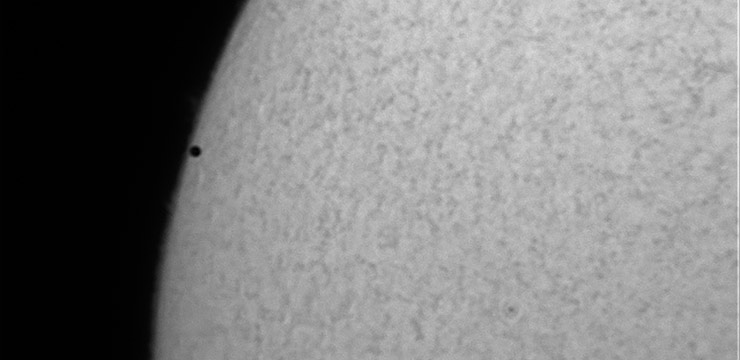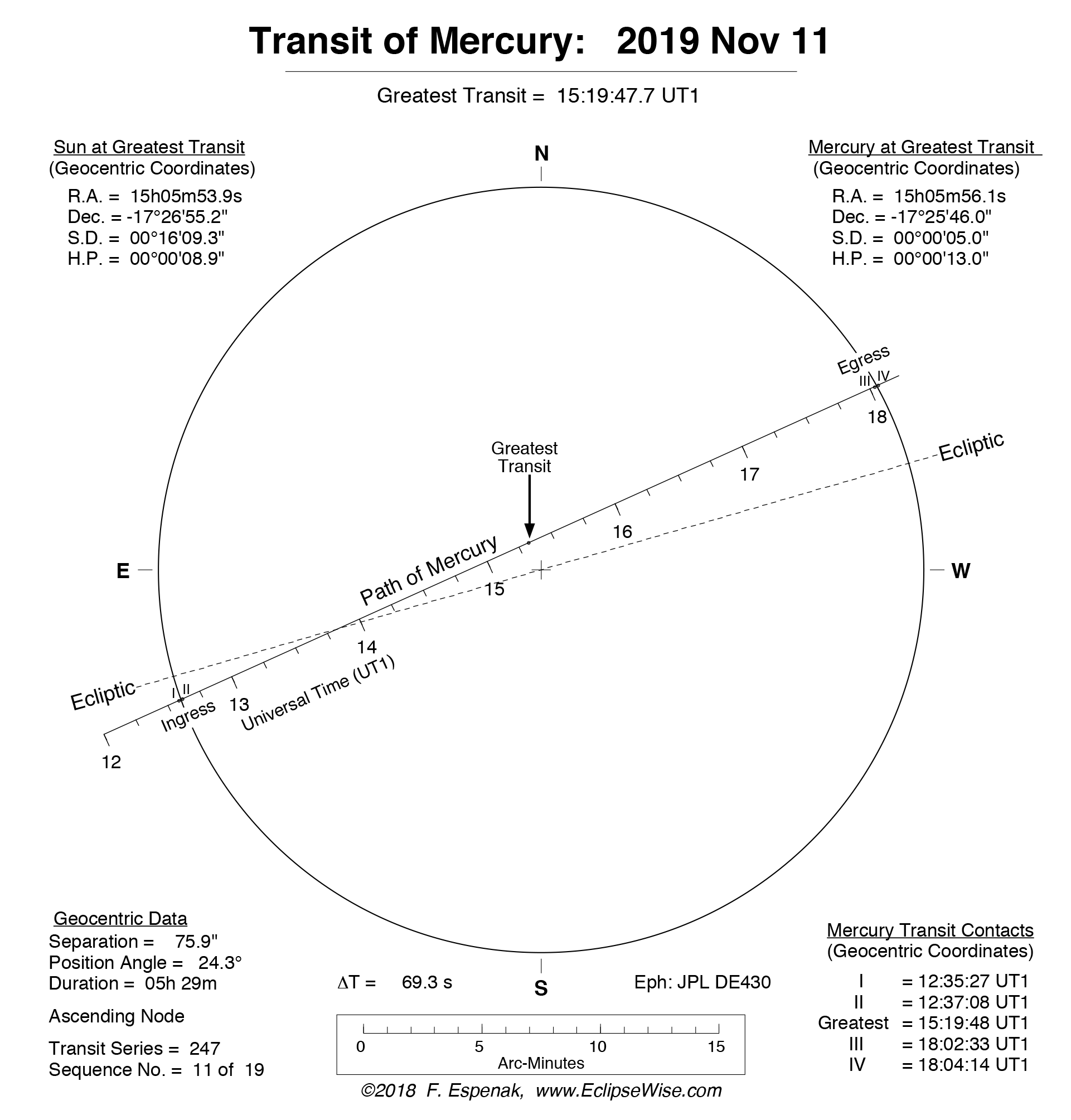
Transit of Mercury A Unique Astronomical Event
November 2019 :
Venus and Mercury transits occur when these worlds, which orbit between the Earth and the Sun, can be seen to pass directly in front of the solar disk and transit across the face of our star. Why don’t we experience a transit of Venus or Mercury every time they pass between the Earth and the Sun (called inferior conjunction)? It all has to do with the orbits of these planets and our ever-changing viewing angle. Most of the time Venus and Mercury pass above or below the solar disk as seen from the Earth. This concept is simply stated here, but it took the greatest astronomical minds of the past to solve this great mystery. The process took much observation, dedication and deduction to determine the solar system design and the celestial mechanics that govern its motion.
Venus transits are rare astronomical events. They always occur in pairs, eight years apart. We last experienced transits of Venus in 2004 and 2012. Their immediate predecessors occurred back in 1884 and 1882. And the next pair won’t be until 2117 and 2125!
However, another planet can transit the Sun—Mercury. Though not as rare as Venus transits, transits of Mercury occur 12-13 times per century. The last one occurred on May 9, 2016 and it was observed in its entirety locally. The Mercury transit prior to that occurred on November 8, 2006, but in Southern New England we were clouded out. Unfortunately, the next one visible here after the upcoming November 11 event won’t be until May 7, 2049.
I encourage the reader to examine the brief article at this website to understand why transits were once so important that expeditions were sent around the world to observe them.
First and foremost I must express several very important words of caution. My mantra is: when observing the Sun, observe caution as well. Do not attempt to observe this event unless you are an experienced solar observer. Mercury is so tiny that you won’t be able to detect it in transit with the naked eye anyway, so don’t be tempted to try. Number 14 welders’ glass will not show Mercury either. DO NOT use exposed film of any kind. This method is not safe under any circumstance. In past columns I have instructed folks on how to build a solar eclipse viewer using a shoe box. This observing method also won’t work in this circumstance because the projected solar disk is so tiny that Mercury’s even smaller silhouette won’t be detectable. Furthermore, unfortunately those solar eclipse glasses practically everyone obtained for the August 21, 2017 solar eclipse will not reveal tiny Mercury’s disk either.
If you have never observed the Sun before this event, don’t start now! Don’t risk your eyesight due to an oversight or an outright mistake. Even if you have one of those department store refractors that often come with small glass or plastic filters, do not be tempted to use them. They have been known to shatter when exposed to the Sun’s concentrated image. (Many years ago, when I first started out in astronomy, I had one of those glass/plastic filters shatter during a partial solar eclipse. Luckily, I wasn’t looking through the eyepiece at the time. But it was a very close call.)
If you use an unfiltered telescope to project the Sun’s image on a white screen, remember to be very cautious if other folks, especially children, are nearby. You don’t want anyone accidentally stepping up to an unguarded eyepiece to take a look. And regarding eyepieces, do not use cemented eyepieces. Use only those that are air-spaced. Eyepieces have been ruined when the cement has melted due to the concentrated sunlight collected by a telescope.
Otherwise, experienced astronomers use special solar filters that prevent more than 99.99% of the light from even entering the telescope. That includes the dangerous infrared wavelength as well.
Regardless of which telescope method you use, please remember to block off your telescope’s finder scope. I have seen observers singe their hair or clothes by failing to do so!!
Our location here in Southern New England will allow us to observe the 2019 transit in its entirety. From start to finish the transit will last five and a half hours. That’s a long duration event to allow interested individuals to be able to view even a few minutes of Mercury’s passage across the solar disk.
Please note that all times with this article are provided in Eastern Standard Time and have been specifically calculated for Providence. (Times do vary slightly by geographic location, so if you are going to be outside of the area, you may want to check online for specifics.)
Locally the transit begins bright and early at 7:34:43 a.m. with the Sun about ten degrees above the southeast horizon. This is the moment of 1st contact when the tiny silhouette of Mercury will begin to appear along the lower left (east) edge of the Sun approximately at the eight o’clock position. Because the Sun arcs across the sky depending upon geographic location, and because we live on the surface of a sphere, the beginning and ending positions will differ greatly from the accompanying graphic. It’s all a matter of perspective. It will take two minutes for Mercury to emerge fully onto the solar disk.
Just before it does so, a keen-eyed observer should notice the “black drop” effect. Many members of Skyscrapers observed this “black drop” during Venus’ transit in 2004. High magnification will be necessary to see this effect due to Mercury’s small size. When Mercury is seen fully in front of the solar disk is the time of 2nd contact at 7:36:24 a.m. The image of Mercury will be quite small and much darker and rounder than any sunspot. (With the Sun currently at solar minimum there will be few if any sunspots to use for comparison.)
Mercury’s motion will continue to carry it across the face of the Sun from east (left) to west (right). The mid-transit point will occur at 10:19:46 a.m. with the Sun 28.6 degrees above the south-southeast horizon. At 1:03:13 p.m. Mercury will reach the right edge of the Sun. This is 3rd contact. Just prior to this time an observer will once again have another opportunity to observe the “back drop” effect. Then at 1:04:54 p.m. Mercury will exit the solar disk completely. This event is called 4th contact. The Sun will then be about 26.8 degrees above the south-southwest horizon.

If you are not an experienced solar observer and wish to experience this transit, you may be able to do so at some of the local observatories. At the time of this writing in early October, only Frosty Drew Observatory at Ninigret Park in Charlestown has an observing program scheduled. If and when any of the other facilities offer Mercury transit observing opportunities, I will email the media with the details.
And heavens forbid the skies are cloudy here on November 11. I’m sure there will be many websites streaming the event live. I agree that watching online sites is not the same as experiencing the transit firsthand, but if the weather doesn’t cooperate, you may have no choice but to pull up a chair in front of your computer screen and watch the progress of the event. This course of action is also an option if you can’t observe it safely yourself or can’t travel to an organized observing program. Should the opportunity pass you by for any reason, you won’t have another chance locally until May 7, 2049.
Good luck in observing this interesting astronomical phenomenon, and remember to keep your eyes safe.
2016 Mercury transit images in hydrogen-alpha light by Jim Hendrickson using Lunt-35.



